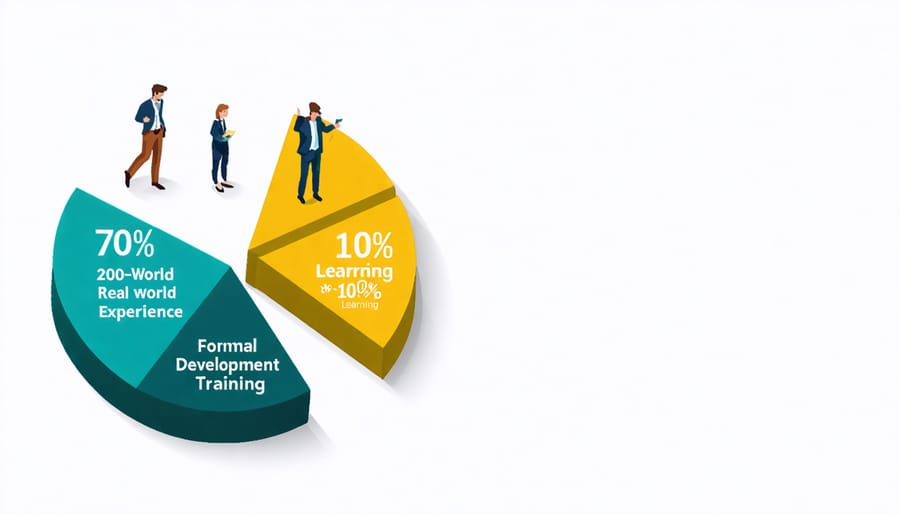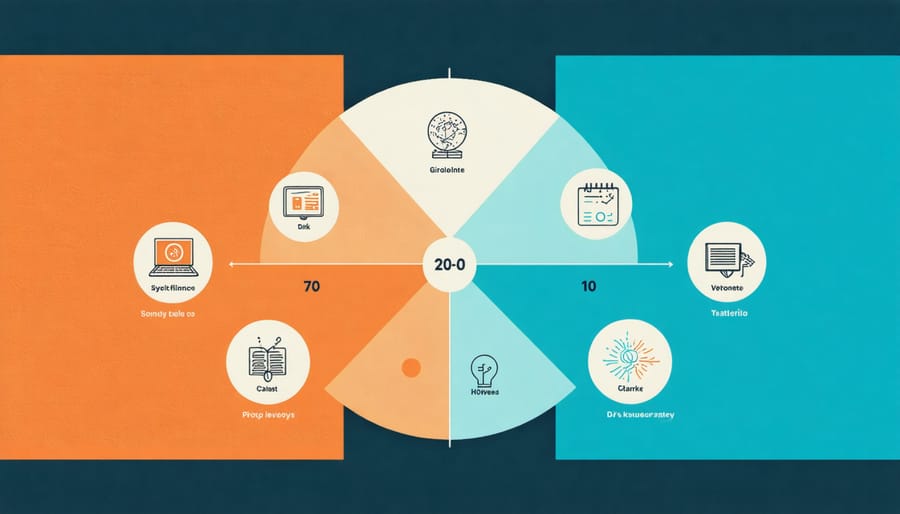
Transform your professional development with Harvard Business Review’s groundbreaking 70-20-10 learning model – a revolutionary framework that mirrors how successful leaders naturally learn and grow. While traditional training programs focus heavily on formal education, research shows that 70% of impactful learning happens through hands-on experience, 20% through social interactions and mentorship, and 10% through structured courses and reading.
Picture this: instead of spending countless hours in workshops, you’re learning while tackling real challenges, collaborating with mentors, and supplementing your growth with targeted formal training. It’s how visionaries like Indra Nooyi and Satya Nadella developed their leadership prowess, and it’s the secret behind many Fortune 500 companies’ talent development strategies.
Whether you’re climbing the corporate ladder or building your own empire, understanding this model isn’t just about following percentages – it’s about intentionally designing your growth journey to maximize impact. Let’s explore how this elegant framework can revolutionize your approach to learning and career development, making every experience count toward your professional evolution.
This scientifically-backed approach has transformed countless careers, and it’s about to change yours too.

Breaking Down the 70-20-10 Learning Framework
The 70%: Learning Through Real-World Experience
Have you ever noticed how much you learn simply by doing your job? That’s exactly what the 70% component of this model represents – learning through hands-on experience and real-world challenges. Think of it as learning to cook by actually preparing meals rather than just reading recipes.
For example, a marketing manager might learn more about social media strategy by running actual campaigns than by attending workshops. Similarly, a team leader develops stronger leadership skills through daily interactions with their team members rather than through theoretical training alone.
The beauty of experiential learning lies in its natural flow. Whether it’s taking on challenging projects, solving unexpected problems, or managing difficult situations, these real-world experiences create lasting knowledge that sticks with you. They provide immediate feedback and allow you to adapt and improve in real-time, making them incredibly effective for long-term professional growth.
The 20%: Social Learning and Mentorship
Have you ever noticed how much easier it is to learn something when you have someone showing you the ropes? That’s exactly what the 20% portion of the learning model represents – the magic that happens through social connections and mentorship. Think of it as your professional support system, where learning flows through conversations, feedback sessions, and those invaluable coffee catch-ups with mentors.
I remember when I first started blogging, it wasn’t the online courses that made the biggest difference – it was the weekly chats with my experienced blogger friend Sarah that really helped me grow. Whether it’s constructive feedback from your manager, brainstorming with colleagues, or formal mentoring relationships, these interactions shape about 20% of our professional development.
This social learning piece is like having a GPS for your career – it helps you navigate challenges, avoid common pitfalls, and discover shortcuts you might never have found on your own.
The 10%: Formal Training
While formal learning represents just 10% of the model, it serves as the essential foundation for professional development. Think of it as the building blocks that support everything else you’ll learn on the job. This structured learning includes modern corporate training, workshops, certification programs, and traditional classroom settings.
What makes this 10% so valuable is its systematic approach to knowledge transfer. It’s where you learn the fundamental theories, industry best practices, and standardized procedures that guide your work. Unlike the more fluid learning that happens through experience and mentorship, formal training provides clear benchmarks for success and measurable outcomes.
The key is to maximize these structured learning opportunities by actively engaging with the material and immediately looking for ways to apply it in your daily work routine. Even though it’s just 10%, it’s the springboard for the remaining 90% of your learning journey.
Making It Work in Your Daily Life
Creating Learning Opportunities at Work
Creating meaningful learning opportunities doesn’t always require formal training sessions. As someone who’s navigated various workplace environments, I’ve discovered that some of the most valuable lessons come from everyday experiences. The key is being intentional about turning regular work situations into engaging learning experiences.
Start by volunteering for challenging projects that stretch your capabilities. When I first raised my hand for a cross-departmental initiative, I was nervous but gained invaluable insights about collaboration and project management. Keep a learning journal to document your daily experiences, challenges, and solutions – this simple practice helps cement lessons learned and creates a valuable resource for future reference.
Make it a habit to ask for feedback after completing tasks, even small ones. This proactive approach not only helps you improve but also signals to your colleagues that you’re committed to growth. Create mini-learning moments by spending the first 15 minutes of your day reading industry news or the last 15 minutes reflecting on what you learned.
Remember, learning opportunities often disguise themselves as everyday challenges. That difficult client conversation? It’s a chance to enhance your communication skills. The new software implementation? An opportunity to develop technical expertise. By reframing challenges as growth opportunities, you’re actively participating in your own development while contributing to your organization’s success.
Building Your Support Network
Building a strong support network is crucial for the “20” portion of the 70-20-10 learning model, and I’ve learned that it’s not just about collecting business cards – it’s about fostering genuine connections. As someone who started her career feeling a bit lost, I discovered that meaningful mentoring relationships develop organically when you approach them with authenticity and purpose.
Start by identifying potential mentors who align with your career goals and values. Look beyond just job titles; consider people whose leadership style and work-life integration inspire you. I found my most valuable mentor during a company volunteer day, proving that connections can spark in unexpected places!
To nurture these relationships, be specific about what you hope to learn. Instead of saying “I’d love to pick your brain,” try “I admire how you handled the recent project transition. Could we discuss your approach over coffee?” This clarity shows respect for their time and demonstrates your commitment to growth.
Remember to be a good mentee – come prepared to meetings, follow through on suggestions, and share your progress. Some of my strongest professional relationships started with a simple LinkedIn message and grew through consistent, thoughtful engagement. The key is to make these connections mutually beneficial – offer your insights, support their initiatives, and celebrate their wins too.
Don’t limit yourself to just one mentor. Different people can guide various aspects of your development, creating a diverse support system that enriches your learning journey.


Real Success Stories
Let me share some inspiring success stories from professionals who’ve transformed their careers using the 70-20-10 learning model. Sarah Thompson, a marketing manager at a Fortune 500 company, credits this approach for accelerating her professional development journey in just 18 months.
“I used to think formal training was everything,” Sarah explains. “But when I started dedicating 70% of my time to hands-on projects, like leading our social media rebranding campaign, I saw real growth. The 20% came from weekly coffee chats with our senior directors, and the 10% from structured workshops. This combination helped me secure a promotion twice as fast as my peers.”
Another success story comes from James Chen, a tech startup founder who implemented the 70-20-10 model across his entire team of 30 employees. “We saw a 40% increase in innovation output within six months,” he shares. “Our developers spent 70% of their time working on challenging projects, 20% collaborating with mentors, and 10% in formal training sessions. The results were remarkable.”
Emily Rodriguez, a human resources professional, transformed her department’s onboarding process using this model. “New hires now spend 70% of their first month actively working on real projects, 20% connecting with experienced team members, and 10% in traditional training. Our employee retention rate improved by 35% in just one year.”
The model proved equally effective in smaller businesses. Take Lisa Morgan’s boutique consulting firm, for instance. She adapted the model for her team of five: “We created a system where everyone spends 70% of their time on client projects, 20% in peer-to-peer learning sessions, and 10% attending industry conferences. Our client satisfaction scores have never been higher, and team confidence has soared.”
These stories demonstrate that whether you’re in a large corporation or a small business, the 70-20-10 model can be adapted to drive remarkable results. The key is maintaining flexibility while staying true to the core principles of experiential learning, social interaction, and formal education.
The 70-20-10 learning model isn’t just another business concept – it’s a practical roadmap that can transform the way we grow and develop in our careers. As someone who has personally experienced the power of this approach, I can tell you that the magic happens when you start viewing every workday as a learning opportunity.
Remember, 70% of your learning comes from those challenging projects and day-to-day experiences. Whether it’s managing a difficult client meeting or figuring out a new software system, these moments are your greatest teachers. The 20% comes from the relationships you build – those coffee chats with mentors, feedback sessions with colleagues, and team collaborations that shape your understanding. And that final 10%? Make it count with focused training that fills specific knowledge gaps.
I encourage you to start small. Maybe begin by keeping a learning journal to track your on-the-job experiences, or reach out to someone you admire for monthly mentoring sessions. The beauty of this model is that it works with your natural learning style while providing structure for intentional growth.
As you embark on your learning journey, remember that everyone’s path looks different. The key is to stay curious, remain open to feedback, and consistently reflect on your experiences. Your growth journey is uniquely yours – embrace it, shape it, and watch as it transforms both your professional and personal life.



